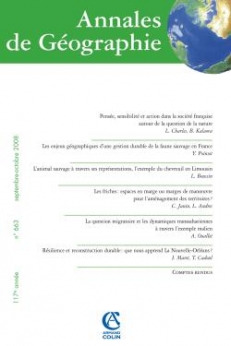
Annales de Géographie n° 663 (5/2008)
Pour acheter ce numéro, contactez-nous
Recevez les numéros de l'année en cours et accédez à l'intégralité des articles en ligne.
Les friches, qu’elles soient rurales ou urbaines, constituent une rupture, un vide, dans un territoire et une société. Toutes ont pour trait commun le fait d’être associées à un processus d’abandon, à une appréhension et un mode de gestion. Toutes peuvent être interrogées en tant que ressources perdues ou futures, par rapport à un système de valeurs (économique, foncier, symbolique, idéel,…). Ce n’est pas tant l’origine des friches, industrielles ou agricoles, qui les distingue, mais leur localisation, leur visibilité et les enjeux dont elles sont l’objet. Cet article s’attache à analyser les formes d’abandon et les modes de gestion des friches, de toutes natures confondues, afin de montrer comment ces espaces acquièrent un statut à part entière dans les processus d’aménagement.
Agricultural or urban derelict lands can be considered as a split, a gap in a territory or a society. Both derelict lands are associated to a process of abandon and land management. Moreover, both derelict lands can be questioned as lost or future resources according to an economic, ideal, symbolic or spatial value. In that sense the following question can be considered as the main guideline of our thought : as abandoned and awaiting territories, can derelict lands be considered as the witnesses of the way a society manages its changes ? This article aims to analyse agricultural and urban derelict lands changes processes as to prove that urban and agricultural derelict lands can not be distinguished by the nature of their previous activity but by their localisation, their visibility and the stakes they are linked to. As derelict lands have more often been analysed according to their nature, this paper brings another regard on the process of abandon and management which can be helpful for research and professional interdisciplinary.

